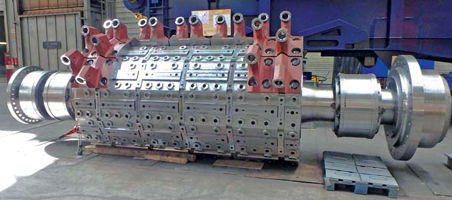2nd Hand Equipment - Coming soon!

We are now putting the final touches to the World Mining Equipment 2nd Hand market place. If you would like information on this service contact


Tenova TAKRAF claimed it has developed a crushing solution for Canada’s oil sands industry that could enable producing companies to sustain profitability in a low oil-price environment.
This advance in crushing technology, said TAKRAF, not only can provide a boost in production, it also permits recovery improvements in the downstream extraction process. And what’s more, according the company, this level of success has been proven during the region’s performance- limiting arctic winter months.
TAKRAF was invited by a major oil sands producer to solve frequent winter- time stalling of its double roll crushers (DRC). A major impact of these stoppages, apart from the immediate inability to restart, was significant cumulative annual restrictions on winter production. TAKRAF began retrofitting all the customer’s primary crushing plants with the New Generation TAKRAF TRC DRC.
According to TAKRAF, an installed New Generation DRC increased drive train inertia more than 200%, useable kinetic energy by 185%, and available motor torque by 168%. This resulted in peak crushing demand dropping from nearly 600% Full Load Torque (FLT) to a level near 350% FLT. A specially designed motor with a Breakdown Torque (BDT) in excess of 430% FLT was then implemented to deliver the full 350% FLT through a larger capacity fluid coupling.
These changes, said TAKRAF, represented a paradigm shift in the basic crushing principles utilized in an oil sands primary crusher. Previously, the technology primarily relied on expending its limited kinetic energy during every major crushing event. However, if the kinetic energy was completely expelled before the feed material was processed, the crusher would stall. Subsequent restart attempts failed and often consumed the available heat capacity of the fluid coupling, further impacting recovery. TAKRAF New Generation DRCs have the ability to process the most difficult materials without primarily relying on consuming any kinetic energy. The inertial storage buffer translates directly to production continuity.
The technology was then applied to the entire primary crushing plant, two trains of which were put into production in 2016. The TAKRAF drive units with higher available kinetic energy have been able to achieve sustained process tonnage rates exceeding 14,000 metric tons per hour (mt/h) while maintaining 400-mm x 400-mm maximum product size — even when the feed approaches a 10:1 crushing ratio. At the same time, the TAKRAF model TRC 25.37 DRC has been able to provide an 11% increase in the surface area of the product, significantly assisting the oil recovery process.
The installed DRCs, according to TAKRAF, are designed for a sustained 17,000-mt/h throughput capacity in all oil sands materials and the most frigid ambient conditions. The two units, which began production in 2016, are detuned to the contracted 14,000-mt/h capacity, but can be restored to full rating with a simple change to the ratio of the apron feeder.
TAKRAF also noted it is currently in the process of developing a range of Extreme Class sizers for applications such as copper or iron ore — materials with difficult-to-crush characteristics that have traditionally exceeded the capability of conventional sizer technology.